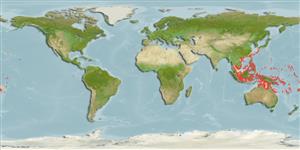Common names from other countries
>
Eupercaria/misc (Various families in series Eupercaria) >
Lutjanidae (Snappers) > Lutjaninae
Etymology: Lutjanus: Malay, ikan lutjan, name of a fish.
More on author: Lacepède.
Environment: milieu / climate zone / depth range / distribution range
Ecologie
marien rifbewoner; diepte 3 - 50 m (Ref. 9710). Tropical; 35°N - 21°S, 93°E - 170°W
Western Pacific: Sumatra to Samoa, north to southern Japan. Apparently restricted to the western Pacific (Ref. 30829).
Grootte / Gewicht / Leeftijd
Maturity: Lm ? range ? - ? cm
Max length : 35.0 cm TL mannelijk / geslacht onbekend; (Ref. 48635); common length : 20.0 cm TL mannelijk / geslacht onbekend; (Ref. 55)
Dorsale stekels (totaal) : 10 - 11; Dorsale zachte stralen (totaal) : 13 - 14; Anale stekels: 3; Anale zachte stralen: 8. Snout somewhat pointed. Eye large. Preorbital bone narrow, its width much less than eye diameter. Preopercular notch and knob well developed. Scale rows on back rising obliquely above lateral line. Generally pink or reddish, white or silvery below. Usually a series of ten to twelve stripes is on the side. Some specimens have black spot on the back below the anterior part of the soft dorsal fin.
Adults inhabit coral reefs. Often seen in schools near outcrops or drop-offs, often with other species (Ref. 9710), of up to about 30 to 40 individuals. Small juveniles on shallow algae reef, often near freshwater run-offs (Ref. 48635). Feed on fishes, shrimps, crabs, other crustaceans, cephalopods and some planktonic items.
Levenscyclus en paargedrag
Maturities | Voortplanting | Spawnings | Egg(s) | Fecundities | Larven
Allen, G.R., 1985. FAO Species Catalogue. Vol. 6. Snappers of the world. An annotated and illustrated catalogue of lutjanid species known to date. FAO Fish. Synop. 125(6):208 p. Rome: FAO. (Ref. 55)
Status op de Rode Lijst van het IUCN (Ref. 130435)
CITES (Ref. 128078)
Not Evaluated
Gevaar voor de mens
Harmless
Gebruik door de mens
Visserij: van minder commercieel belang
Tools
Speciale rapporten
Download XML
Internetbronnen
Estimates based on models
Preferred temperature (Ref.
115969): 24.3 - 29, mean 28.2 (based on 542 cells).
Fylogenetische diversiteitsindex (Ref.
82804): PD
50 = 0.5000 [Uniqueness, from 0.5 = low to 2.0 = high].
Bayesian length-weight: a=0.01479 (0.00706 - 0.03101), b=2.97 (2.81 - 3.13), in cm Total Length, based on LWR estimates for this Genus-body shape (Ref.
93245).
Trofisch niveau (Ref.
69278): 3.8 ±0.56 se; based on food items.
Weerstandsvermogen (Ref.
120179): Hoog, minimale populatieverdubbelingstijd minder dan 15 maanden (Preliminary K or Fecundity.).
Fishing Vulnerability (Ref.
59153): Low vulnerability (25 of 100).
